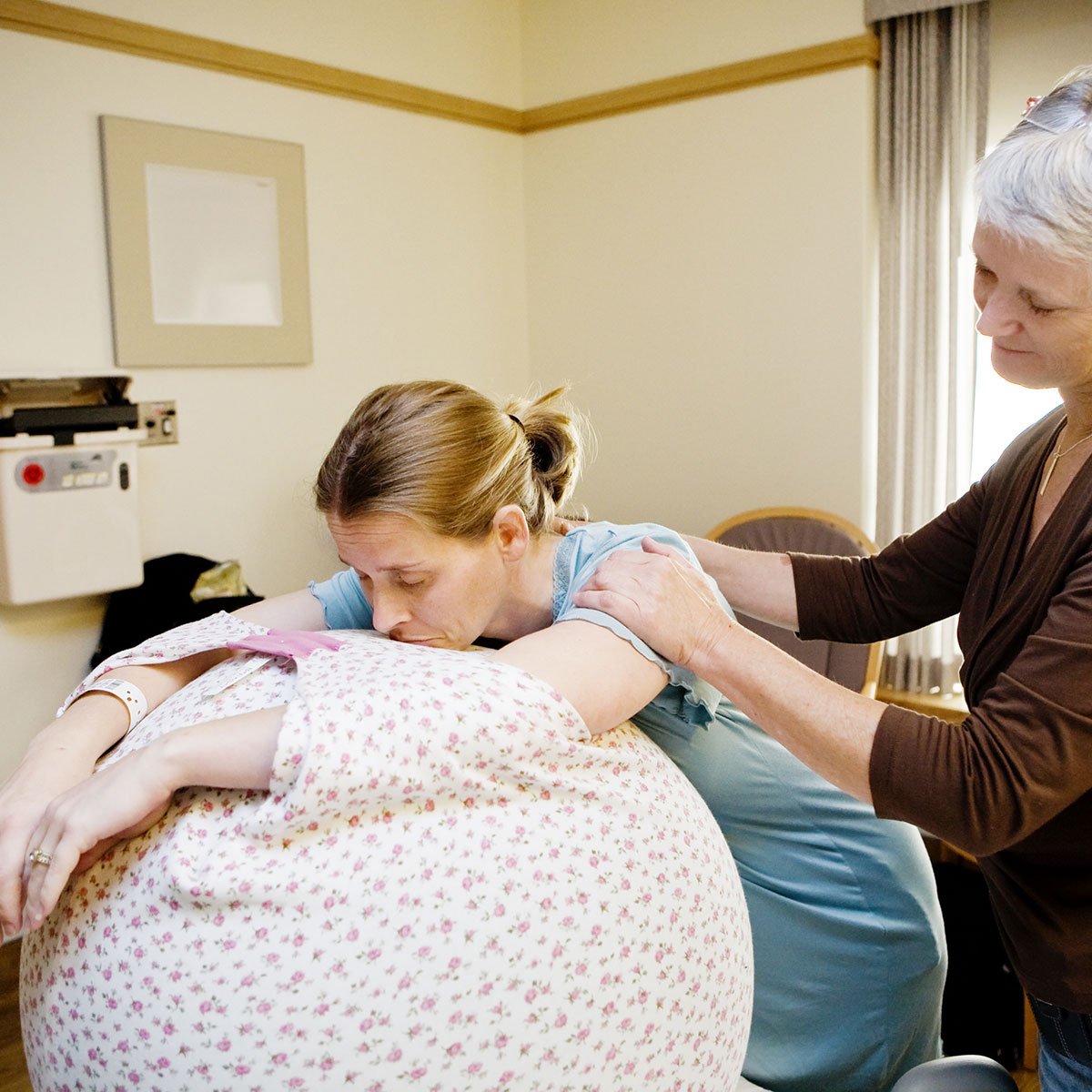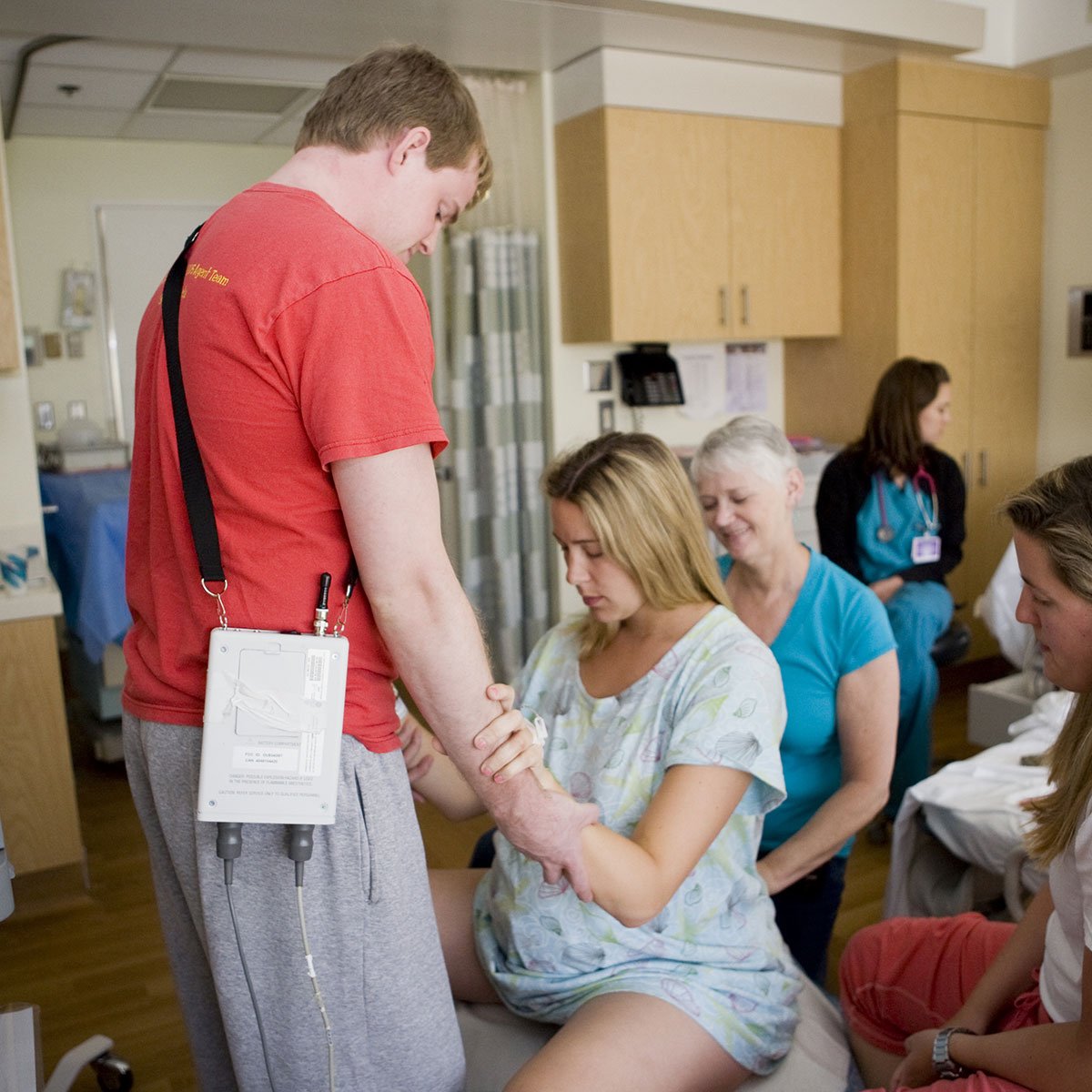Using a Birth Ball in Labor
(see photos of one way to use a birth ball below)
The Birth Ball is the same as the physical therapy balls which have been used for years by physical therapists in a variety of ways in treating orthopedic and neurological disorders, and for exercise. It is also an excellent and relatively inexpensive comfort tool for pregnancy and labor and postpartum.
Most women prefer the 65 cm size ball. These can be purchased at any medical supply store for almost half the price you’d pay at specialty massage stores. Look for one that will hold at least 300 pounds and is burst resistant, meaning that the air will leak out slowly if the ball is punctured.
If I could only bring one “tool” to a birth, it would be the birth ball. In over 24 years of doula work, I’ve only had one client out of more than 680, who didn’t like sitting on the birth ball during labor! A birth ball can help reposition a posterior (sunny side up) baby, provide access to your back for your partner or doula to give you a massage or counter pressure, helps keep you out of the bed, and, when you’re not using the ball, it’s a great place for your doula, your partner or a friend to sit!
When you inflate your ball, it should be should be slightly firm and large enough for you to sit on with your knees and hips bent at 90-degree angles. Sitting on the ball instead of in a recliner will help prevent a posterior baby, it can relieve the low backache of pregnancy, and you will probably find it unbelievably comfortable.
There are lots of ways to use the ball — here are just a few:
The hands and knees position can be very comfortable for many women in labor, but your hands will become numb very quickly. If you get on your knees and rest your head and arms on the ball, there is less strain on the hands and arms and you will be able to spend more time in this relaxing position.
You can sit on the ball, with your partner or doula standing behind you and supporting you. Your legs should be about two feet apart so your feet and butt form a triangle for good balance. You should feel stable and secure. This position helps improve your posture, encourages you to rock side to side or forward and back or in circles, thereby giving the baby a better angle to enter your pelvis.
My favorite position requires two support people, usually the partner and the doula, but a mother, sister or friend would work just as well. The partner sits on the bed, facing the laboring woman sitting on the ball. The doula is behind the woman and is sitting on a stable chair (not one with wheels). During a contraction, mom leans forward and puts her head on the partner’s lap (pillows can be placed on the lap for the laboring woman’s comfort). This gives the doula great access to the woman’s lower back for massage, pressure, heat or cold packs. Between the contractions, the woman leans back against the doula and the doula gently rocks with her from side to side. This is a great opportunity for the doula to help the woman relax between contractions and prepare for the next one.
If you sit on the ball and lean forward against the bed, your partner or doula will have good access to your lower back for counter pressure or massage. Sitting on warm compresses on the ball will maximize perineal relaxation and help you avoid an episiotomy.
If you’re having a long, non-progressing labor, it often means that your baby’s head is turned slightly to the side and not in a good position for delivery. If this happens, you can get into the hospital bed with the foot lowered as far as it can go. Put the ball on the lowered foot of the bed and you on your knees, with your head and arms resting on the ball, so your hips are higher than your shoulders. This position will help baby to slip away from the position he or she is stuck in and to reposition for an easier birth.
The ball can be placed on the bed if you are standing and you can lean forward, resting your head and arms on the ball for a comfortable, leaning forward position to encourage pelvic swaying.
If you are standing and swaying, the ball can be placed against the wall and you can lean back against it for wonderful back support and pressure, helping you to sway from side to side and relax. Have your partner or doula hold it against the wall until you are leaning against it comfortably.
Be sure to clean the ball well after your birth. I use a 10% bleach solution in a spray bottle to clean mine. It’s also a good idea to cover the ball with a Chux pad, even if you use a birth ball cover, so it won’t get wet when your bag of waters ruptures. Remember that the ball will be coming home in your car or van after the birth!
If you have a doula, she will most likely bring her birth ball to your birth, but you might want to buy your own ball. It can be used as a rocking chair when baby comes, bouncing or rocking on it can help to quiet a fussy baby. It can also be used for colic by holding the baby on his or her stomach on the ball and gently rocking; the pressure on the baby’s abdomen seems to help (NEVER take your hand off the baby when doing this, of course!).


